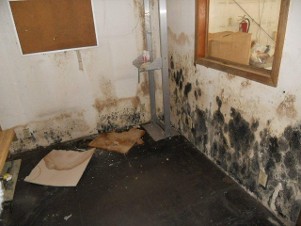Mold In Your Basement
 Basement Mold Remediation Guidelines
Basement Mold Remediation Guidelines
Once the source of the moisture is corrected, remediation (mold removal, clean-up, abatement) of the molds/bacteria will be determined by the material that the mold resides on and the area of the affected air quality.
Personal Protection:
The remediation contractor should use Personal Protective Equipment (PPE) to protect themselves against contamination. All precautions should be taken to protect the occupants of the home and currently unaffected areas of the home from exposure during remediation.
Containment:
All affected areas must be contained during remediation. The containment should be constructed of a minimum 6-mil thick polyethylene sheathing with the preferred method being a “zipper” containment. Containment should remain intact until a post-remediation report is produced indicating that the remediation effort has successfully solved the problem. Containment should NOT be altered or even entered by any person other than the remediation contractors or the indoor air quality consultant unless specific authorization has been given.
Material Handling:
All moldy or damaged materials from the remediation project should be placed in sealed 6-mil Polyethylene bags if they are to be transported through “clean” areas prior to disposal.
Hard Surfaces:
Surfaces such as countertops, hard un-lined HVAC ducts, concrete, glass, plastic, steel studs or joists. The mold can be cleaned with SHOCKWAVE – Disinfectant an EPA registered disinfectant, mold killer with over 140 kill claims.
Semi-Porous Materials:
Wood products such as wood studs or joists, paneling, furniture. If the structural integrity of the material has not been compromised and there is access to properly treat, the material may be wire brushed to remove the visible mold and/or bacteria, cleaned with Advanced Peroxide Cleaner, and coated with IAQ-6000 (Clear) or 6100 (white) . an EPA registered mold resistant coating. If structural integrity is compromised or proper access cannot be gained, then removal of the material is necessary to ensure remediation.
Porous Surfaces:
Gypsum drywall, boxes, paper products such as newspapers & books, cabinets, carpeting, OSB, soft furniture, or other particle-board. It is always best to replace the affected material and dispose of it. Cleaning and HEPA vacuuming may help but is probably only a band-aid. Clothing should be thoroughly cleaned to remove any mold spores. If the clothing is no longer worn, it would be a good time to dispose of it.
Basement Remediation Protocol (example)
Exterior Moisture Issues
Fix all water (moisture) intrusions.
Basement Containment
Erect a proper containment at the basement entry area per the guidelines above. Seal off all HVAC supply and return registers.
Maintain the relative humidity in the work area at 50% or less during remediation.
Clean and store or dispose of all possessions in the affected area per the guidelines above.
Demolition (Removal):
Walls:
Remove all drywall to a height of 8 ft. in the indicated area. If visible fungal growth is still observed on the rear of the wall covering or on framing, continue outward and upward until clean material is observed, remove any cavity insulation, repair any water damaged framing members. Remove the exterior substrate.
Ceiling:
Remove the drywall to a width of 2 feet along the area that contacts the removed wall area. If visible fungal growth is still observed on the rear of the ceiling or on framing, continue outward in all directions until clean material is observed. Remove any cavity insulation, repair any water damaged framing members.
Flooring:
Remove all carpet. Replace water damaged subfloor.
Cleaning:
Wire brush or sand all exposed framing members; treat all exposed framing/subfloor with Advanced Peroxide Cleaner per the guidelines above. An advanced abrasion techniques may be used if the work area is too difficult to sand or wire brush.
After all other remediation’s are performed, the remediated area should be air-scrubbed for a minimum of 48 hours at a rate of 6 air exchanges per hour.
§ Remove air-scrubbers or cover all input and output ports of the air-scrubbers after turning them off to prevent re-contamination of the cleaned area

